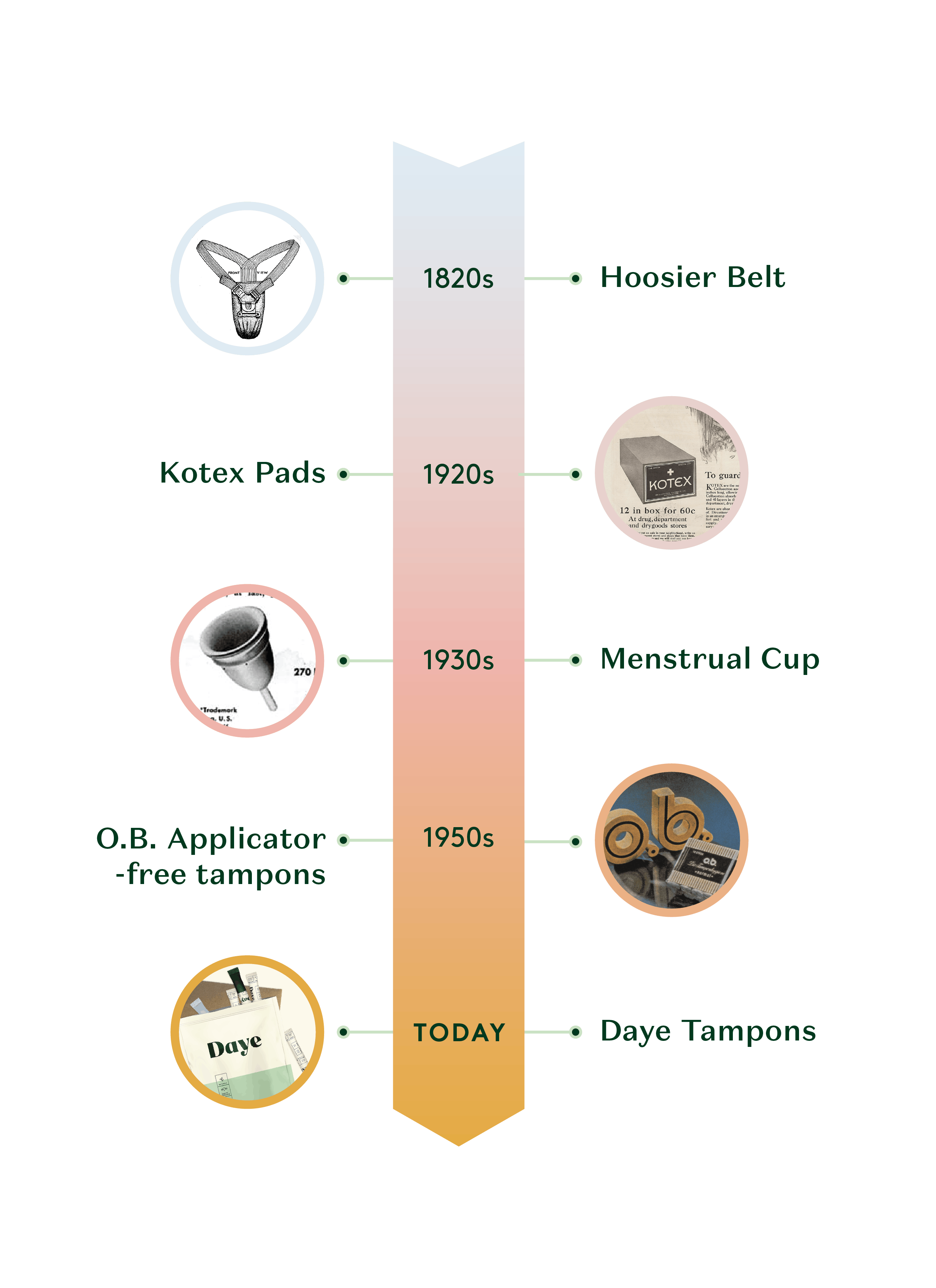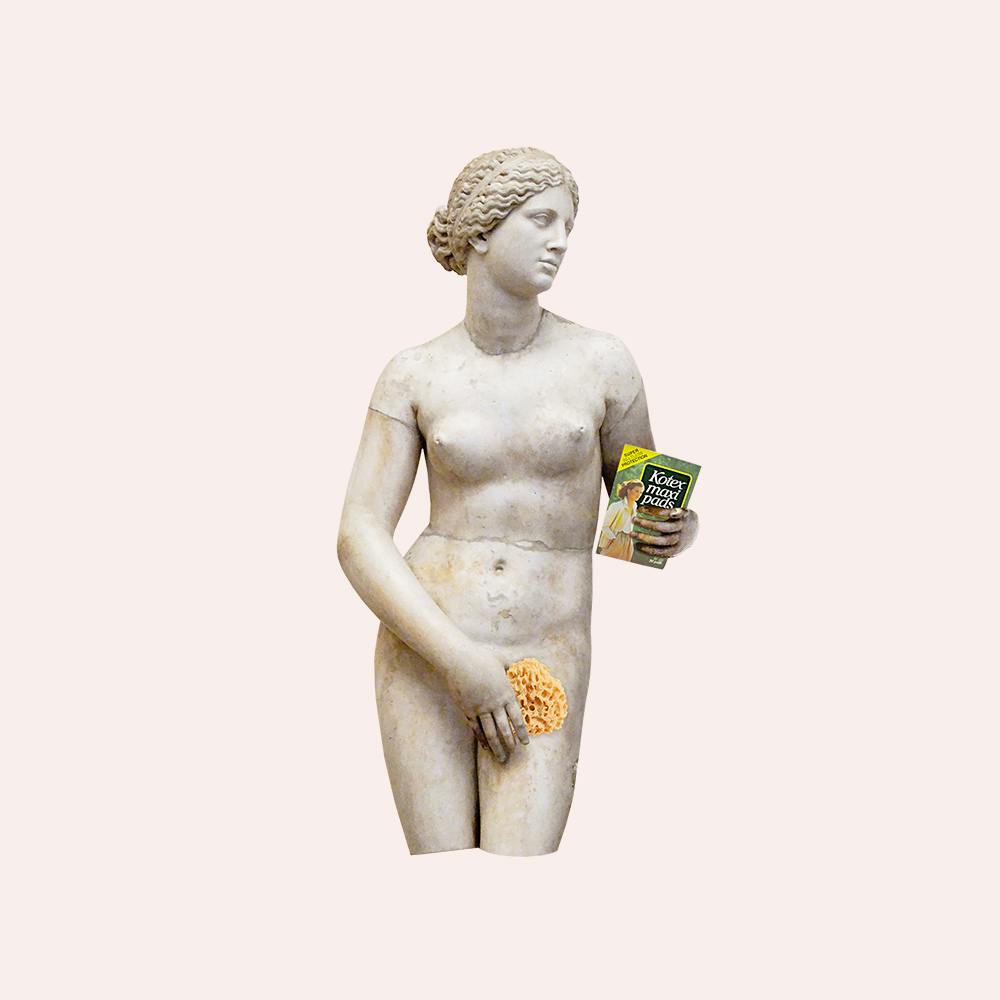Illustrated by Erin Rommel
The femcare industry is hardly perfect, but it’s safe to say that most—not all—people who menstruate are covered when it comes to sanitary products. From menstrual cups and period underwear, to cramp-fighting tampons (*wink wink*) there’s seemingly something for everyone.
But what about way back when technology wasn’t as sophisticated and period positivity wasn’t society’s cause célèbre? In honour of Menstrual Hygiene Day, a global advocacy platform dedicated to raising awareness about period hygiene, we look back at the varied, sometimes bizarre, often frustratingly misogynist history of period products.
Ancient times
Full disclosure: we don’t know much about how people handled their blood flow in ancient times. There’s very little documentation about menstruation back then, partly due to the fact that women didn’t talk about it, and partly because scribes were mostly men, who didn’t think periods were worth recording in history. Typical.
There are a lot of theories floating around about how women DIY’d period care. It’s said that Ancient Greek women used small wooden sticks wrapped in lint as tampons, Egyptian women went for rolled up papyrus, while Roman women preferred cotton. Rumour has it Indonesian women used vegetable fibre to staunch their flow, while African women used rolls of grass.
Although we’d like to believe that women have always been ingenious and crafty like that, these theories are likely conjecture. One of the oldest sanitary products on record, however, is actually still used today: the sea sponge (although the jury’s still out on whether or not they’re the most hygienic method).
The Middle Ages
Once again, historians don’t have much to work with here, so any documentation about menstruation during the medieval period is mostly based on speculation. The scholar who knows the most about menstruation and the Middle Ages is Dr. Sara Read, a historian who specialises in female health in early modern European culture. According to Dr. Read, back then women often fashioned pads out of rags—from which the term “on the rag” originated— but since most women went commando, it’s more correct to assume that they just free bled.
Unsurprisingly, with the rise of Christianity also came shame associated with periods, so women went to great lengths to cover up that time of the month. Historian Dr. Greg Jenner writes that women carried nosegays (small flower bouquets) around their necks or waists to mask the smell of menses, and curbed heavy flows with medicines made from powdered toad. He also adds that the Church didn’t allow pain relief, because apparently God wanted menstrual cramps to serve as a reminder of Eve’s Original Sin. Not much of a market for Daye, then.

1800s
The word “period” as a term for menstruation first comes into use in 1822, and towards the end of the century, people started realising that just bleeding into one’s clothes wasn’t exactly sanitary. Enter: the Hoosier Sanitary Belt, a contraption that pinned to a washable cloth pad. Then, in 1888 Johnson & Johnson launches Lister’s Towels, the first disposable menstrual pad to be commercially available, but because menstruation was such a taboo topic, the product had very little success and was soon pulled from market.
1920s
During WWI, nurses figured out that cellulose, a highly absorbent material used to bandage wounds, also did a pretty good job at absorbing menstrual blood. Kotex gets wind of this idea and develops a disposable cellulose menstrual pad, which became very popular among wealthy white women who shopped in department stores. They would take a box of pads and then clandestinely leave a nickel on the store counter, in total discretion (buying pads directly from a salesperson was strictly verboden). But it wasn’t until 1929 that things get interesting, and a physician called Dr. Earle Haas develops the first applicator tampon.
1930s
In 1937, American actress Leona Chalmers patented a design for a menstrual cup made of latex that would allow women to wear tight-fitting clothes without belts or pads showing. During WWII, however, a shortage of latex forced companies to stop production. But her efforts weren't all lost, because her design gave birth to the modern menstrual cups many people use today, which are now made of silicone.
1950s
In 1950 O.B. launches their applicator-free tampons in Europe. They were smaller in size and more discreet to carry, so they became the most popular choice. Meanwhile, in the US, Chalmers patented a new design for her menstrual cup, but sales never really took off because women weren’t comfortable with the idea of having to empty and clean the cup.
1970s
Procter & Gamble had the (misguided) idea to make the world’s most absorbent tampon, the Rely. It was made from a synthetic material and could supposedly be worn for the length of an entire period. After 5 years and over 800 cases of toxic shock syndrome, they were pulled off the market. Shocker. Luckily, O.B. released their tampons in the US in the late 70’s.
1980s
By the 1980s the Hoosier belt was almost entirely faded out of circulation, and pads had adhesive strips that would attach to underwear. But perhaps the most momentous change was that the word “period” was spoken out loud in a commercial for the first time ever by Courtney Cox, in a Tampax ad.
Present Day
Sanitary products today are generally safer and more effective, although no solution is fool-proof. Every person who menstruates has the right to manage their period however they feel most comfortable—whether that means tampons, moon cups or pads—so it’s a good thing that we have more choice than the generations that came before us.
That being said, modern period care is still a privilege. Many girls and women around the world are still forced to fashion sanitary products with anything they can find, and Plan International UK found that 42% of girls age 14-21 had been forced to use makeshift sanitary wear like toilet paper and socks because they struggled to afford sanitary products.
Access to decent menstrual hygiene is a basic human right, so although we’ve come a long way from bulky sanitary belts and unhygienic tampons, we still have a lot of work to do.
To help fight period poverty and guarantee every person has access to sanitary products, visit Bloody Good Period and Period Project.






